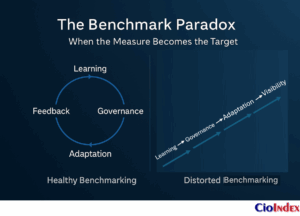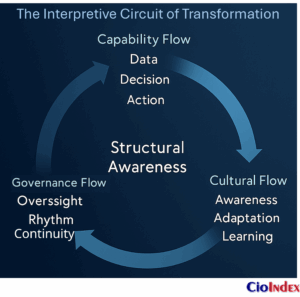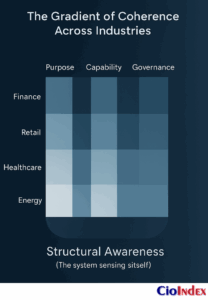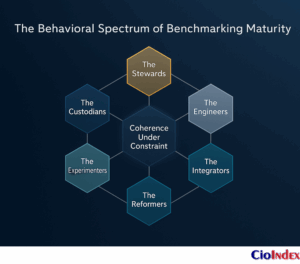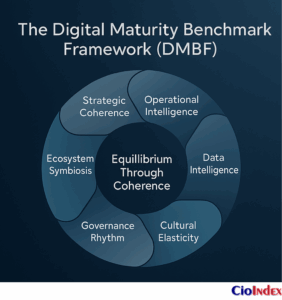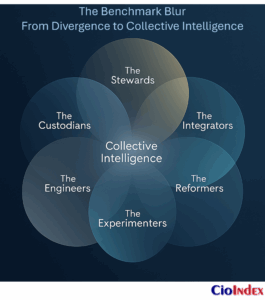The Benchmark Imperative — Measuring Meaning, Not Motion
Digital transformation has entered its most revealing phase—the moment when progress must be proven, not proclaimed.
Enterprises have modernized systems, digitized workflows, and declared victories measured in deployment milestones. Beneath those metrics lies a harder question: what has actually changed in the organization’s ability to learn, decide, and adapt?
Benchmarks answer that question only when they measure meaning rather than motion. They move beyond counting what is installed to assessing what is integrated—how technology, culture, and governance interact as a single learning system. They expose the strategic architecture of progress—the connections between intent and capability, between decision velocity and coherence. Benchmarks do not quantify transformation; they qualify its intelligence.
Traditional measurement systems still chase efficiency. They count savings, cycle times, and automation ratios—the mechanical afterglow of modernization. Benchmarks belong to a different order of inquiry. They examine rhythm and resilience: how quickly insight circulates through the enterprise, how consistently values guide digital decisions, how effectively feedback becomes foresight. As transformation saturates every function, benchmarks have become the only reliable mechanism for distinguishing activity from evolution.
A company can migrate every platform to the cloud and still operate with pre-digital reflexes. It can publish dashboards dense with performance data yet remain blind to how those signals relate. Transformation succeeds only when measurement captures that relationship—when information flows into action without distortion or delay. The benchmark imperative is calibration, not comparison. It asks whether an enterprise’s internal rhythm matches the volatility of its environment. The measure of progress is not the number of systems running but the coherence with which they think together.
This distinction separates momentum from mastery. Digital leaders treat benchmarking as an instrument of self-awareness—a structural audit of how learning travels through the organization. Their scorecards operate like living systems, sensing imbalance before it becomes inertia. Laggards, by contrast, still rely on static metrics that report yesterday’s efficiency while tomorrow’s complexity accumulates unseen.
The pattern is clear: enterprises that benchmark coherence outperform those that benchmark completion. They use measurement to maintain rhythm, not to document history. The benchmark becomes a feedback architecture—a way of keeping transformation alive, precise, and directional.
This is the benchmark imperative: progress defined by synchronization rather than speed, by awareness rather than accumulation. What matters now is not how much has changed, but how intelligently the organization continues to change.
The Benchmarking Paradox
Benchmarking was conceived as a discipline of truth—a way to separate confidence from evidence. It promises clarity through comparison, a method to verify progress against an external standard. Between intention and distortion lies a narrow space—the point where measurement stops informing behavior and begins shaping it. Once an organization performs for the metric, the signal it produces begins to lose integrity.
This is the paradox at the heart of benchmarking: the pursuit of objectivity can create its opposite. Numbers flatten nuance. A benchmark captures alignment only for a moment, freezing what should remain dynamic. Over time, organizations learn to optimize for visibility—to meet the measure rather than master the mechanism behind it. What begins as a search for coherence can devolve into performance for display.
The distortion is subtle but cumulative. Efficiency improves while adaptability stalls, and dashboards multiply even as meaning thins—the metrics accumulate, but comprehension does not. Transformation becomes theater: progress recorded, not realized. The measure starts to dominate the mindset, and the benchmark transforms from lens to limit.
When measurement begins to dictate meaning, only leadership can restore balance between evidence and understanding. Used correctly, benchmarking exposes how an enterprise learns, decides, and governs under pressure. Used superficially, it rewards conformity and penalizes curiosity. The first accelerates awareness; the second institutionalizes imitation.
Leadership determines which outcome prevails. Mature leaders understand that benchmarks are mirrors, not trophies. They treat comparison as inquiry—an instrument to study structural integrity rather than to validate performance. The goal is not to look better than others but to see more clearly into oneself.
The contrast is decisive. Organizations that use benchmarking as reflection uncover the geometry of their learning systems: where insight circulates freely and where it dissipates. Those that use it as validation gain numbers without knowledge. One sustains intelligence; the other sustains illusion.
At its highest maturity, benchmarking measures sincerity—the alignment between declared ambition and actual capability. It tests whether progress reflects conviction or compliance. When comparison becomes consciousness, the paradox resolves itself.
The Logic of Benchmarking in Transformation
Transformation replaces linear control with continuous interpretation. Systems, people, and information move at different speeds; benchmarks provide the translation layer that keeps them in relation. Their logic is not arithmetic but alignment—the discipline of ensuring that insight, decision, and behavior remain connected as complexity grows.
Where traditional metrics record performance, benchmarking interprets behavior. It clarifies how capability evolves, how learning propagates, and how governance sustains direction under pressure. The goal is not confirmation of progress but detection of coherence—seeing whether the organization still learns as one system.
Benchmarking functions through three interacting flows:
1. Capability Flow – From Integration to Intelligence
This flow traces how technical systems and processes generate usable understanding. It measures the integrity of data circulation and the quality of decisions that result. The signal of maturity is not speed of automation but the accuracy with which insight reaches its destination.
2. Cultural Flow – From Awareness to Adaptation
Here benchmarking examines the enterprise’s cognitive metabolism—how fast reflection becomes redesign. It measures not participation but permeability: the degree to which new knowledge passes through hierarchy without distortion.
3. Governance Flow – From Oversight to Rhythm
Governance converts information into continuity. Benchmarks at this level test whether accountability adapts with circumstance and whether oversight amplifies, rather than interrupts, learning velocity.
The flows converge into an interpretive circuit that allows transformation to sense itself—translating scattered data into structural awareness. A benchmark, properly designed, does not declare success; it maintains equilibrium. It is less a mirror of performance than an instrument of navigation.
This is the logic of benchmarking in transformation: measurement functioning as interpretation, structure preserving motion, precision serving coherence.
The Cross-Industry Maturity Gradient
Transformation advances through different forms of resistance. Each industry evolves within its own field of gravity—regulation, capital, culture, and risk—creating a gradient of maturity rather than a ladder of progress. Benchmarks reveal this gradient by showing how coherence and learning behave under different constraints.
Maturity is not acceleration; it is composition. Progress measures scale, maturity measures structure. Industry context magnifies that distinction, shaping how capability, governance, and intent reinforce—or contradict—one another.
Highly regulated sectors cultivate stability but sacrifice agility. Consumer-driven markets optimize speed but struggle to preserve continuity. Between those poles, every industry composes a distinct rhythm of control and adaptation. Benchmarking converts these variations into comparable patterns of intelligence.
Mapping the Gradient
Six sectors illustrate how coherence takes shape under different structural pressures. Each resolves the same equation—purpose, capability, and governance — in its own proportion.
Finance — Governed Intelligence
In finance, governance itself becomes the benchmark. Regulation transforms from restraint to measurement, turning control into an index of trust. Compliance frameworks, cybersecurity discipline, and capital oversight produce structural integrity but slow experimentation. Maturity depends on translating that discipline into agility—where oversight protects innovation instead of preventing it.
Insight: Trust is not sentiment; it is infrastructure.
Healthcare — Ethics as Architecture
Healthcare’s complexity is not technological but linguistic: information exists in abundance yet speaks in incompatible dialects. Benchmarks here measure interoperability, privacy, and the ethical velocity of data sharing. The test is whether precision can coexist with empathy—how systems learn without violating dignity.
Insight: Ethical design is the new metric of medical maturity.
Manufacturing — From Control to Comprehension
Manufacturing leads in automation and analytics yet often confuses precision with intelligence. Sensors, twins, and predictive models deliver control, but insight remains localized. Benchmarking in this domain evaluates translation—how operational data becomes strategic understanding. When production systems learn as quickly as they produce, efficiency evolves into awareness.
Insight: A process becomes intelligent when it explains itself.
Energy and Utilities — Sustainability as System
For energy enterprises, transformation and sustainability are one equation. Smart grids and sensor networks connect performance with environmental consequence. The benchmark measures how ecological data integrates with financial and operational metrics—governance expanding from compliance to stewardship.
Insight: Sustainability is no longer a value; it is a variable in every decision.
Retail — Experience under Pressure
Retail operates where behavior becomes data in real time. Personalization, logistics, and pricing converge into a continuous feedback engine. Benchmarks test coherence under velocity: can the enterprise preserve alignment when each transaction rewrites expectation? Maturity lies in stability without stillness—the ability to learn faster than customers change.
Insight: Volatility is manageable only when experience and governance share the same dashboard.
Public Sector — Transparency as Performance
Public institutions transform through purpose rather than profit. Their benchmark is trust—the degree to which digital systems reinforce accountability and access. The challenge is not technology adoption but policy synchronization: aligning mission, process, and transparency as one framework. When citizens can trace decisions as easily as outcomes, transformation becomes legitimacy.
Insight: In public systems, visibility is the measure of value.
Across these variations, one pattern emerges: maturity forms where purpose, capability, and governance reinforce each other faster than conditions erode them. Each sector demonstrates a different equation of coherence under constraint, revealing how benchmarking adapts meaning to context.
The gradient is not fixed. Knowledge migrates where readiness allows—financial discipline informs healthcare data ethics; retail analytics inspire manufacturing insight; energy governance shapes public accountability. Benchmarks expose these intersections, showing that maturity now grows through exchange as much as through expertise.
Transformation, seen through this lens, becomes a study in composition. Industries differ less by the technologies they deploy than by how effectively they synchronize ambition, learning, and oversight. Benchmarking renders those rhythms visible, converting diversity into collective intelligence.
Behavioral Archetypes of Benchmarking Maturity
Beneath sector differences lie deeper behavioral patterns—recurring archetypes that describe how organizations sustain coherence under stress.
These archetypes transcend industries; they capture the psychology of transformation rather than its geography.
1. The Custodians — Governance as Gravity
These enterprises mature through control and continuity, stabilizing trust as their central competence. Their strength lies in governance rhythm; their limitation is flexibility.
Paradox: The systems that preserve confidence often resist renewal.
2. The Stewards — Ethics as Architecture
Stewards define transformation through purpose. They translate values into operational design and treat ethics as infrastructure. Measures emphasize transparency, consent, and equitable data exchange. Their challenge is speed—ensuring that moral coherence keeps pace with digital acceleration.
Paradox: When intent moves slower than information, ethics becomes drag instead of direction.
3. The Engineers — Precision as Control
Engineers pursue mastery through measurement. They optimize operations until systems run flawlessly, yet struggle when asked to evolve beyond the known. Their advantage lies in operational and data intelligence; their vulnerability is rigidity.
Paradox: When perfection is achieved, learning stops.
4. The Integrators — Sustainability as System Memory
Integrators view transformation as synthesis. They embed purpose across strategy, operations, and data, turning sustainability into a living operating principle. Their signature is coherence—the degree to which every decision echoes long-term stewardship.
Paradox: Integration breeds strength but also inertia; the system that harmonizes everything adapts to nothing too quickly.
5. The Experimenters — Experience as Feedback
Experimenters evolve through motion. They inhabit volatility, transforming each customer interaction into a feedback mechanism for learning. Their maturity is measured not by stability but by sensitivity—the accuracy with which they interpret change.
Paradox: Speed becomes intelligence only when it is accompanied by reflection.
6. The Reformers — Purpose as Performance
Reformers convert accountability into innovation. Their maturity arises through transparency and inclusion—the ability to turn public scrutiny into collective progress. They appear most visibly in government and mission-driven sectors but increasingly influence corporate governance.
Paradox: In open systems, legitimacy replaces competition as the engine of improvement.
These six archetypes define the behavioral spectrum of benchmarking maturity. Each represents a distinct way of sustaining coherence under constraint.
The Custodians preserve trust; the Stewards preserve integrity; the Engineers preserve precision; the Integrators preserve balance; the Experimenters preserve agility; the Reformers preserve legitimacy.
Benchmarks do not judge difference; they translate it — turning diversity into design.
Archetypes are not confined to industries; they describe behaviors that recur across them.
Finance gravitates toward custodial discipline, healthcare toward stewardship, manufacturing toward engineering control, energy toward integrative balance, retail toward experimentation, and the public sector toward reform. Each pattern represents a gravitational center of maturity shaped by environment and expectation.
As benchmarking evolves, organizations migrate between archetypes—borrowing strength from one to offset fragility in another. This migration marks the onset of convergence, where coherence matures into collective intelligence.
The Systemic Forces Behind Divergent Maturity
The uneven pace of transformation is not the result of ambition but of environment. Every enterprise evolves within a constellation of external forces that either compound learning or constrain it. Benchmarks make these forces visible, showing that divergence is structural before it is cultural.
Five systemic forces govern how maturity develops. Each acts as both catalyst and constraint—the variable that determines whether transformation compounds or diffuses.
1. Regulatory Density — The Geometry of Permission
Regulation defines the shape within which innovation can occur. In dense environments such as finance or healthcare, every advance must pass through layers of scrutiny designed for risk prevention, not adaptive learning. Benchmarks in these sectors measure the agility of compliance—the ability to integrate oversight into design rather than applying it after the fact.
Insight: Regulation slows velocity only when governance and imagination move on separate tracks.
2. Capital Velocity — The Energy of Change
Capital determines how quickly intent becomes infrastructure. High-velocity markets convert investment into experimentation; slow-moving capital elongates feedback loops. Benchmark signals here include reinvestment rate and learning return—how effectively financial momentum sustains innovation without eroding discipline.
Insight: Transformation accelerates when capital funds iteration, not imitation.
3. Data Fluidity — The Circulation of Intelligence
Information is the bloodstream of transformation. Where data flows freely across boundaries, learning compounds; where it stalls, coherence decays. Benchmarks assess the permeability of data ecosystems—how governance enables exchange without losing integrity. The issue is not quantity but connectivity: the degree to which information finds its purpose.
Insight: Maturity begins when information moves faster than hierarchy.
4. Expectation Pressure — The Pace of Relevance
Markets and citizens continuously redefine what “good” looks like. Expectation pressure measures how external demand accelerates internal adaptation. In consumer contexts this pressure enforces agility; in mission-driven institutions it tests resilience. Benchmark expression: response latency—the time between signal and adjustment.
Insight: Relevance is a moving target measured by reflex, not rhetoric.
5. Purpose Cohesion — The Gravity of Meaning
Purpose anchors transformation in intent. When vision fragments, so does maturity. Benchmarks examine alignment: whether purpose cascades through decision systems, incentives, and governance with structural clarity. Cohesive purpose reduces organizational entropy; it keeps learning directional under stress.
Insight: Purpose is the only stabilizer that strengthens with motion.
These forces operate in tension, defining each industry’s transformation geometry. Regulatory density resists speed; capital velocity demands it. Data fluidity dissolves friction; expectation pressure creates it anew. Purpose cohesion holds them in equilibrium.
Benchmarking turns these variables into diagnostics—revealing where resistance converts to learning and where it becomes drag. Divergence across industries is not failure but physics: each sector finding its own balance between control, capability, and coherence. These diagnostics set the scaffold for the Digital Maturity Benchmark Framework that follows.
The Digital Maturity Benchmark Framework (DMBF)
The measure of transformation has shifted from results to relationships—how purpose, learning, and governance operate in concert.
The Digital Maturity Benchmark Framework (DMBF) addresses that need. It does not rank performance or prescribe stages; it maps relationships—how purpose, learning, and governance synchronize to sustain adaptation under pressure.
The framework interprets transformation as a system of six interdependent dimensions. Each dimension represents a property of coherence; none matures in isolation. Progress emerges when they reinforce one another, forming a self-correcting network of intelligence.
1. Strategic Coherence — The Alignment of Intent
Transformation begins to mature when purpose, investment, and execution share a common logic. Strategic coherence measures that alignment—how vision translates into resource allocation and operational behavior. A coherent strategy exerts gravitational pull; decisions orbit around shared intent rather than isolated ambition.
Insight: Alignment is not agreement; it is the consistency of translation from purpose to practice.
2. Operational Intelligence — The Integration of Learning
Every process either learns or decays. Operational intelligence evaluates how automation and feedback converge into collective learning. It is less about efficiency than awareness—the ability to sense variation and respond without command. Benchmarks here measure signal integrity: how quickly observation becomes action.
Insight: Automation delivers speed; intelligence delivers symmetry.
3. Data Intelligence — The Continuity of Insight
Data is the connective tissue of transformation. It links perception to decision, event to interpretation. Benchmarks assess how information is captured, contextualized, and converted into shared understanding across functions and partners. Data maturity reflects not volume but veracity in motion—the precision, ethics, and interpretability with which insight travels through the enterprise.
Insight: Data becomes intelligence only when it teaches the system that created it.
4. Cultural Elasticity — The Capacity to Absorb Change
Transformation endures only as quickly as culture can stretch. Cultural benchmarks measure curiosity, trust, and permeability—the freedom with which ideas move through the organization without distortion. Elasticity prevents stress from becoming fracture; it allows learning to extend without losing form.
Insight: Culture matures when it learns faster than its environment changes.
5. Governance Rhythm — The Continuity of Oversight
Governance defines maturity not through control but through cadence—the timing and proportionality of oversight. Benchmarks assess how accountability adapts with circumstance, ensuring transparency without inertia. Rhythm transforms compliance from restraint into balance.
Insight: Governance achieves maturity when accountability moves at the speed of change.
6. Ecosystem Symbiosis — The Expansion of Value Boundaries
No enterprise transforms alone. Ecosystem symbiosis measures the maturity of external collaboration—how partners, regulators, and customers exchange data, trust, and intelligence. Benchmarks test permeability at scale: how the organization compounds learning through connection rather than protection.
Insight: In adaptive systems, boundaries are not walls but membranes.
Maturity emerges through relationship — the quality of connection among the parts that sustain it.
Strategic coherence without data intelligence breeds blind conviction. Operational intelligence without governance rhythm accelerates risk. Cultural elasticity without purpose diffusion loses direction. Ecosystem symbiosis without ethical data foundations erodes trust. Only when these properties evolve in relation does transformation become systemic.
The DMBF functions less as a scorecard than as a structural sensor — an interpretive instrument that reveals how an enterprise maintains equilibrium while moving through change. It transforms benchmarking from measurement into architecture, from observation into navigation.
The New Benchmark Blur: When Industries Converge
Industry boundaries no longer hold. Digital transformation has turned specialization into exchange — finance adopting retail agility, healthcare learning from data science, energy borrowing from software logic. The measure of progress now lies in connection, not classification.
This is the benchmark blur — the point where advancement moves faster than industry boundaries can contain it. Patterns that once distinguished custodians from experimenters or engineers from integrators now overlap, forming hybrid systems that learn through exchange. What began as divergence has become circulation.
The benchmark is evolving from comparison to cross-pollination. The measure is no longer how one sector performs against another but how effectively intelligence transfers across them. Advancement in this new landscape is defined by permeability — the capacity to absorb, reinterpret, and redeploy insight regardless of origin. Coherence becomes compositional rather than categorical.
The Mechanics of Convergence
Convergence emerges through translation, not imitation. Enterprises absorb disciplines rather than devices — the governance of finance, the ethics of healthcare, the precision of manufacturing, the sustainability of energy.
Each exchange transfers not process but philosophy—the architecture of learning itself. The distinction between best practice and shared intelligence dissolves. What remains is a collective vocabulary of coherence.
Insight: Transformation no longer competes across industries; it compounds through them.
The Hybrid Enterprise
In the benchmark blur, archetypes merge into hybrid forms.
Custodians become Data Custodians, combining governance rigor with real-time analytics.
Stewards evolve into Adaptive Stewards, embedding ethics in algorithmic design.
Engineers become Learning Engineers, joining precision with cultural permeability.
Integrators expand into Circular Integrators, linking sustainability with ecosystem collaboration.
Experimenters mature into Disciplined Experimenters, balancing agility with oversight.
Reformers transform into Network Reformers, embedding transparency in shared platforms.
These hybrids illustrate a larger truth: coherence is now horizontal rather than vertical. Each enterprise functions within a distributed network of learning, where progress in one domain accelerates awareness in another.
Insight: The modern measure is not a mirror of performance but a conduit of exchange.
The Measure in a Convergent World
As industries fuse, the measure evolves again — from score to signal, from output to orchestration. It detects where coherence strengthens and where it decays.
Comparative benchmarking yields to relational benchmarking, assessing how effectively an organization sustains shared intelligence within its ecosystem.
This shift redefines advancement — from individual mastery to collective resilience.
The measure no longer isolates — it synchronizes, transforming competition into coordination and enabling shared stability through mutual learning.
Insight: Progress is measured by how effectively intelligence circulates.
The Architecture of Collective Intelligence
At its highest form, benchmarking becomes architecture — a living network of signals connecting enterprises through shared purpose and pattern.
The six dimensions of the DMBF — strategy, operations, data, culture, governance, and ecosystem — form the grammar of this collective intelligence.
Each enterprise contributes a phrase; together they compose a language of adaptation.
Through this grammar, transformation acquires memory. The distinction between industry and intelligence dissolves into continuity of learning.
Insight: Collective intelligence begins when organizations stop protecting knowledge and start translating it.
Convergence does not erase difference; it elevates it into dialogue. Each sector contributes a discipline the others lack—governance, ethics, precision, sustainability, adaptability, legitimacy.
The benchmark blur fuses these into one ecosystem of coherence, where learning itself becomes the measure of progress.
From Comparison to Architecture
The benchmark has outgrown its origins as a mirror for performance. It no longer measures outcomes; it designs relationships. What began as a tool for evaluation has become a system for equilibrium—a framework through which intelligence circulates and coherence sustains itself under pressure.
Benchmarking no longer describes progress; it constructs it. Each enterprise becomes a structural node in a wider network of learning, where stability depends less on control than on connection. Progress is not recorded but continually recomposed through shared rhythm.
The purpose of benchmarking, finally, is not judgment but geometry — the arrangement of purpose, data, and governance into patterns that endure change. When measured through this lens, transformation reveals its most durable truth: systems mature when they learn how to hold their shape while moving.
